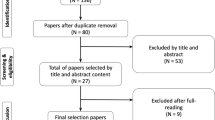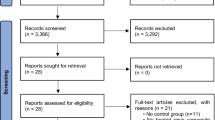Abstract
Objective
The main aim of this study was to conduct an integrative review on the influence of the zirconia veneer thickness on the degree of conversion of resin-matrix cements.
Materials and method
An electronic search was performed on PubMed using a combination of the following search items: zirconia, thickness, veneer, degree of conversion, resin cement, light curing, and polymerization. Articles published in the English language, up to July 2020, were included regarding the influence of ceramic veneer thickness on the degree of conversion of resin-matrix cements. Randomized controlled trials and prospective cohort studies were also evaluated.
Results
Of the 21 selected studies, 9 investigated the light-curing effect, while five other articles evaluated the ceramic translucency. Three studies evaluated the degree of conversion of the resin-matrix cement while four articles assessed the veneer thickness. Results revealed a significant decrease of light transmission through the zirconia with a thickness ranging from 0.1 up to 1.5 mm. However, the ultra-thin thickness around 0.1 and 0.3 mm allowed a full polymerization of the dual-curing resin-matrix cement resulting in the integrity of the interface properties. The light-curing process of resin-matrix cements is also affected by the shade, chemical composition, and microstructure of zirconia and resin cement. Optimal conditions of light-curing are required to reach the threshold intensity of light and energy for polymerization of resin-matrix cements.
Conclusions
The increase in zirconia veneer thickness negatively affects the degree of conversion of resin-matrix cements. Also, shade and microstructure are key factor to improve the light curing of resin cements.
Clinical relevance
Clinicians should consider the zirconia thickness on resin-based cementation since a higher veneer thickness can negatively affect the light irradiation intensity towards the dual-curing resin-matrix cement. Thus, the degree of conversion of the resin-matrix cement can decrease leading to a low chemical stability (e.g., color instability) and poor mechanical properties.


Similar content being viewed by others
References
Zhang Y, Lawn BR (2018) Novel zirconia materials in dentistry. J Dent Res 97:140–147. https://doi.org/10.1177/0022034517737483
Lümkemann N, Pfefferle R, Jerman E, Sener B, Stawarczyk B (2020) Translucency, flexural strength, fracture toughness, fracture load of 3-unit FDPs, Martens hardness parameter and grain size of 3Y-TZP materials. Dent Mater 36:838–845. https://doi.org/10.1016/j.dental.2020.03.027
Stawarczyk B, Frevert K, Ender A, Roos M, Sener B, Wimmer T (2016) Comparison of four monolithic zirconia materials with conventional ones: contrast ratio, grain size, four-point flexural strength and two-body wear. J Mech Behav Biomed Mater 59:128–138. https://doi.org/10.1016/j.jmbbm.2015.11.040
Egilmez F, Ergun G, Cekic-Nagas I, Vallittu PK, Ozcan M, Lassila LVJ (2013) Effect of surface modification on the bond strength between zirconia and resin cement. J Prosthodont Off J Am Coll Prosthodont 22:529–536. https://doi.org/10.1111/jopr.12030
Pereira L d L, Campos F, Dal Piva AM d O et al (2015) Can application of universal primers alone be a substitute for airborne-particle abrasion to improve adhesion of resin cement to zirconia? J Adhes Dent 17:169–174. https://doi.org/10.3290/j.jad.a33974
Henriques B, Fabris D, Tuyama E, Mesquita-Guimarães J, Silva FS, Souza JCM, Fredel M (2019) Shear bond strength of PEEK and PEEK-30GF cemented to zirconia or titanium substrates. J Adhes Sci Technol 33:1090–1101. https://doi.org/10.1080/01694243.2019.1565289
Özcan M, Bernasconi M (2015) Adhesion to zirconia used for dental restorations: a systematic review and meta-analysis. J Adhes Dent 17:7–26. https://doi.org/10.3290/j.jad.a33525
Ilie N, Stawarczyk B (2014) Quantification of the amount of light passing through zirconia: the effect of material shade, thickness, and curing conditions. J Dent 42:684–690. https://doi.org/10.1016/j.jdent.2014.03.007
Tribst JPM, Dal Piva AM d O, Penteado MM et al (2018) Influence of ceramic material, thickness of restoration and cement layer on stress distribution of occlusal veneers. Braz Oral Res 32:e118. https://doi.org/10.1590/1807-3107bor-2018.vol32.0118
Turp V, Ongul D, Gultekin P et al (2015) Polymerization efficiency of two dual-cure cements through dental ceramics. J Istanbul Univ Fac Dent 49:10–18. https://doi.org/10.17096/jiufd.25575
Ioannidis A, Muhlemann S, Ozcan M et al (2019) Ultra-thin occlusal veneers bonded to enamel and made of ceramic or hybrid materials exhibit load-bearing capacities not different from conventional restorations. J Mech Behav Biomed Mater 90:433–440. https://doi.org/10.1016/j.jmbbm.2018.09.041
Harada K, Raigrodski AJ, Chung K-H, Flinn BD, Dogan S, Mancl LA (2016) A comparative evaluation of the translucency of zirconias and lithium disilicate for monolithic restorations. J Prosthet Dent 116:257–263. https://doi.org/10.1016/j.prosdent.2015.11.019
Turp V, Sen D, Poyrazoglu E, Tuncelli B, Goller G (2011) Influence of zirconia base and shade difference on polymerization efficiency of dual-cure resin cement. J Prosthodont Off J Am Coll Prosthodont 20:361–365. https://doi.org/10.1111/j.1532-849X.2011.00721.x
Kim M-J, Kim K-H, Kim Y-K, Kwon T-Y (2013) Degree of conversion of two dual-cured resin cements light-irradiated through zirconia ceramic disks. J Adv Prosthodont 5:464–470. https://doi.org/10.4047/jap.2013.5.4.464
Alovisi M, Scotti N, Comba A, Manzon E, Farina E, Pasqualini D, Michelotto Tempesta R, Breschi L, Cadenaro M (2018) Influence of polymerization time on properties of dual-curing cements in combination with high translucency monolithic zirconia. J Prosthodont Res 62:468–472. https://doi.org/10.1016/j.jpor.2018.06.003
Guazzato M, Albakry M, Ringer SP, Swain MV (2010) Strength, fracture toughness and microstructure of a selection of all-ceramic materials . Part I . Pressable and alumina glass-infiltrated ceramics. Dent Mater 20:441–448
Guazzato M, Albakry M, Ringer SP, Swain MV (2004) Strength, fracture toughness and microstructure of a selection of all-ceramic materials. Part I. Pressable and alumina glass-infiltrated ceramics. Dent Mater 20:441–448. https://doi.org/10.1016/j.dental.2003.05.003
Caprak YO, Turkoglu P, Akgungor G (2019) Does the translucency of novel monolithic CAD/CAM materials affect resin cement polymerization with different curing modes? J Prosthodont Off J Am Coll Prosthodont 28:e572–e579. https://doi.org/10.1111/jopr.12956
Capa N, Celebi C, Casur A, Tuncel I, Usumez A (2017) The translucency effect of different colored resin cements used with zirconia core and titanium abutments. Niger J Clin Pract 20:1517–1521. https://doi.org/10.4103/njcp.njcp_160_17
Sulaiman TA, Abdulmajeed AA, Donovan TE, Ritter AV, Vallittu PK, Närhi TO, Lassila LV (2015) Optical properties and light irradiance of monolithic zirconia at variable thicknesses. Dent Mater 31:1180–1187. https://doi.org/10.1016/j.dental.2015.06.016
Turp V, Turkoglu P, Sen D (2018) Influence of monolithic lithium disilicate and zirconia thickness on polymerization efficiency of dual-cure resin cements. J Esthet Restor Dent Off Publ Am Acad Esthet Dent 30:360–368. https://doi.org/10.1111/jerd.12390
Gultekin P, Pak Tunc E, Ongul D et al (2015) Curing efficiency of dual-cure resin cement under zirconia with two different light curing units. J Istanbul Univ Fac Dent 49:8–16. https://doi.org/10.17096/jiufd.97059
Paes PNG, Bastian FL, Jardim PM (2017) The influence of Y-TZP surface treatment on topography and ceramic/resin cement interfacial fracture toughness. Dent Mater 33:976–989. https://doi.org/10.1016/j.dental.2017.06.004
Thompson JY, Stoner BR, Piascik JR, Smith R (2011) Adhesion/cementation to zirconia and other non-silicate ceramics: where are we now? Dent Mater 27:71–82. https://doi.org/10.1016/j.dental.2010.10.022
Vrochari AD, Eliades G, Hellwig E, Wrbas K-T (2009) Curing efficiency of four self-etching, self-adhesive resin cements. Dent Mater 25:1104–1108. https://doi.org/10.1016/j.dental.2009.02.015
Sulaiman TA, Abdulmajeed AA, Donovan TE, Ritter AV, Lassila LV, Vallittu PK, Närhi TO (2015) Degree of conversion of dual-polymerizing cements light polymerized through monolithic zirconia of different thicknesses and types. J Prosthet Dent 114:103–108. https://doi.org/10.1016/j.prosdent.2015.02.007
Lopes C d CA, Rodrigues RB, Silva ALFE et al (2015) Degree of conversion and mechanical properties of resin cements cured through different all-ceramic systems. Braz Dent J 26:484–489. https://doi.org/10.1590/0103-6440201300180
De Souza G, Braga RR, Cesar PF, Lopes GC (2015) Correlation between clinical performance and degree of conversion of resin cements: a literature review. J Appl Oral Sci 23:358–368. https://doi.org/10.1590/1678-775720140524
Noronha Oliveira M, Schunemann WVH, Mathew MT, Henriques B, Magini RS, Teughels W, Souza JCM (2018) Can degradation products released from dental implants affect peri-implant tissues? J Periodontal Res 53:1–11. https://doi.org/10.1111/jre.12479
Souza JCM, Sordi MB, Kanazawa M, Ravindran S, Henriques B, Silva FS, Aparicio C, Cooper LF (2019) Nano-scale modification of titanium implant surfaces to enhance osseointegration. Acta Biomater. 94:112–131
Schünemann FH, Galárraga-Vinueza ME, Magini R, Fredel M, Silva F, Souza JCM, Zhang Y, Henriques B (2019) Zirconia surface modifications for implant dentistry. Mater Sci Eng C 98:1294–1305. https://doi.org/10.1016/j.msec.2019.01.062
Bansal R, Taneja S, Kumari M (2016) Effect of ceramic type, thickness, and time of irradiation on degree of polymerization of dual - cure resin cement. J Conserv Dent 19:414–418. https://doi.org/10.4103/0972-0707.190010
Shiomuki D, Minami H, Tanaka T, Suzuki S (2013) Influence of light irradiation on Vickers hardness of dual-cure cement polymerized under restorations. Dent Mater J 32:449–455. https://doi.org/10.4012/dmj.2012-306
Malkondu O, Tinastepe N, Kazazoglu E (2016) Influence of type of cement on the color and translucency of monolithic zirconia. J Prosthet Dent 116:902–908. https://doi.org/10.1016/j.prosdent.2016.05.001
Inokoshi M, Pongprueksa P, De Munck J et al (2016) Influence of light irradiation through zirconia on the degree of conversion of composite cements. J Adhes Dent 18:161–171. https://doi.org/10.3290/j.jad.a35842
Valentino TA, Borges GA, Borges LH, Vishal J, Martins LRM, Correr-Sobrinho L (2010) Dual resin cement knoop hardness after different activation modes through dental ceramics. Braz Dent J 21:104–110. https://doi.org/10.1590/s0103-64402010000200003
Shim JS, Kang JK, Jha N, Ryu JJ (2017) Polymerization mode of self-adhesive, dual-cured dental resin cements light cured through various restorative materials. J Esthet Restor Dent Off Publ Am Acad Esthet Dent 29:209–214. https://doi.org/10.1111/jerd.12285
Shim JS, Han SH, Jha N, Hwang ST, Ahn W, Lee JY, Ryu JJ (2018) Effect of irradiance and exposure duration on temperature and degree of conversion of dual-cure resin cement for ceramic restorations. Oper Dent 43:E280–E287. https://doi.org/10.2341/17-283-L
Akar GC, Pekkan G, Cal E et al (2014) Effects of surface-finishing protocols on the roughness, color change, and translucency of different ceramic systems. J Prosthet Dent 112:314–321. https://doi.org/10.1016/j.prosdent.2013.09.033
Pozzobon JL, Pereira GKR, Wandscher VF, Dorneles LS, Valandro LF (2017) Mechanical behavior of yttria-stabilized tetragonal zirconia polycrystalline ceramic after different zirconia surface treatments. Mater Sci Eng C Mater Biol Appl 77:828–835. https://doi.org/10.1016/j.msec.2017.03.299
Kumagai N, Hirayama H, Finkelman MD, Ishikawa-Nagai S (2013) The effect of translucency of Y-TZP based all-ceramic crowns fabricated with difference substructure designs. J Dent 41(Suppl 3):e87–e92. https://doi.org/10.1016/j.jdent.2012.10.005
Ilie N, Bauer H, Draenert M, Hickel R (2013) Resin-based composite light-cured properties assessed by laboratory standards and simulated clinical conditions. Oper Dent 38:159–167. https://doi.org/10.2341/12-084-L
Funding
This work was supported by the following FCT (Portuguese foundation) projects: UID/EEA/04436/2013, NORTE-01-0145-FEDER- 000018, (HAMaBICo), and POCI-01-0145-FEDER-031035 (Laser MultiCER)].
Author information
Authors and Affiliations
Corresponding author
Ethics declarations
Ethical approval
This article does not contain any studies with human participants or animals performed by any of the authors
Informed consent
For this type of study, formal consent is not required.
Conflict of interest
The authors declare no competing interests.
Additional information
Publisher’s note
Springer Nature remains neutral with regard to jurisdictional claims in published maps and institutional affiliations.
Rights and permissions
About this article
Cite this article
Tafur-Zelada, C.M., Carvalho, O., Silva, F.S. et al. The influence of zirconia veneer thickness on the degree of conversion of resin-matrix cements: an integrative review. Clin Oral Invest 25, 3395–3408 (2021). https://doi.org/10.1007/s00784-021-03904-w
Received:
Accepted:
Published:
Issue Date:
DOI: https://doi.org/10.1007/s00784-021-03904-w




